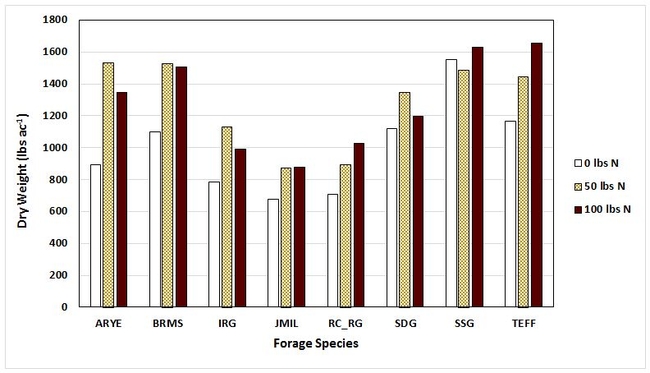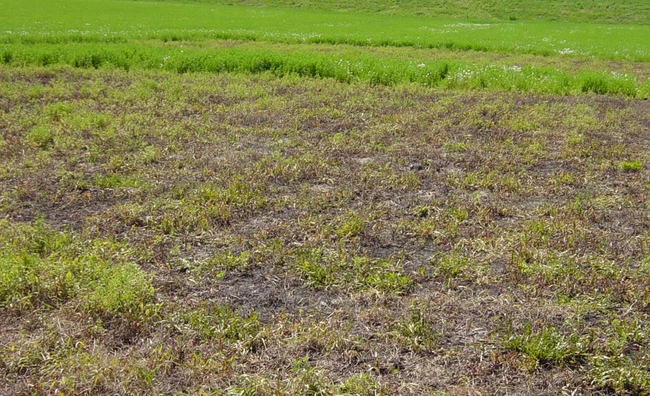When hay prices and demand for forages are high, there’s incentive to increase forage system productivity, especially for alfalfa.
Semi-dormant alfalfa varieties have been heavily promoted and widely adopted, as part of an effort to maximize forage production during the upper Midwest’s relatively short growing season.
However, this can increase the chance of winter injury and winterkill. For example, during the 2012-2013 winter, significant acres of alfalfa in Minnesota experienced winter injury and winterkill.
Research: Alternative forages after alfalfa winterkill
In years when alfalfa is injured by the winter and cool, wet springs persist, options to replant both annual row crops and forages can become more limited.
Warm-season grasses could provide an alternative emergency forage during such years. Because many warm-season grass species require warmer soils for germination, planting as late as July can provide forage during a reduced growing season.
Researchers conducted initial emergency forage trials near Rosemount in 2013.
Research assessed the following six warm-season grasses on yield potential and response to nitrogen (N) fertilization and cutting management: Japanese millet, Siberian foxtail millet, teff, brown midrib (BMR) sorghum, annual ryegrass and perennial ryegrass.
Grasses were cut at the early vegetative stage one month after the June 5 planting date and again on Sept. 1.
Forage yield and quality results
-
BMR sorghum yielded the highest of all grasses, producing more than 6 tons per acre of dry matter.
-
Teff, a warm-weather annual grass adapted to moisture regimes ranging from low desert sands to waterlogged clays, produced above 5 tons per acre.
-
Perennial ryegrass was among the lowest-yielding species at 1.7 tons per acre.
-
Based on neutral detergent fiber digestibility (NDFD), BMR sorghum was among the highest-quality grasses, while Siberian millet was among the lowest.
-
Nitrogen fertilizer had no effect on the total dry matter production (i.e., yield in tons per acre) across all seven species. This indicates the winter-killed alfalfa supplied enough nitrogen (N) to meet the needs of all grasses.
Similar to 2013, harvest intervals in 2014 began 30 days after planting and continued every 30 days, concluding in early September.
Researchers selected grasses based on forage performance in the initial year. This follow-up experiment continues to utilize Japanese millet, teff, BMR sorghum and annual ryegrass, plus introduced sudangrass, sorghum sudangrass, Italian ryegrass and a red clover-annual ryegrass bi-culture.
Forage yield and N rate results
Yield data from the first harvest in Rosemount (2014) provides insight into preliminary results (Figure 1).
Findings include:
-
Sudangrass produced the greatest average yield across N rates at 1.41 tons per acre, closely followed by BMR sorghum at 1.40 tons per acre.
-
Japanese millet returned the lowest average yield potential with 0.67 tons per acre.
-
BMR sorghum, Italian ryegrass, the red clover-annual ryegrass mix and teff showed consistent yield response to increased N.
-
BMR sorghum with 100 pounds of N per acre produced the greatest treatment yield, at 1.64 tons per acre.
Weed management challenges
Field observations in Waseca indicate intensive weed management may be critical to stand establishment (Photo 2).
Sudangrass and teff appear to have established and maintained the strongest persistence despite heavy weed pressure in all treatments.
Teff responded very well to the high seeding rate, with greater germination and stand establishment. It produced relatively tight, dense growth, inhibiting weed encroachment and establishment.
While competitive and well-established, teff didn’t yield as highly, due to its low growth habit and the cutting height used. Sudangrass also displayed strong and competitive establishment potential and quickly closed, with enough tall, broad leaves to shade out most competition.
Higher-fertilized treatments of BMR sorghum and Japanese millet also appear to produce relatively well. Sorghum sudangrass, annual ryegrass, Italian ryegrass and the red clover-ryegrass mixture have generally performed very poorly in this weedy location.
This emergency no-till forage research has been continuing with the goal of developing tools for producers faced with extreme winterkill in alfalfa or prevented planting.
Noland, R.L., Wells, M.S., Sheaffer, C.C., Coulter, J.A., & Becker. R. (2017). Yield, nutritive value, and profitability of direct-seeded annual forages following spring-terminated alfalfa. Agronomy Journal, 109, 1-11.
Reviewed in 2018




